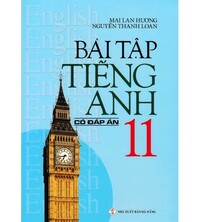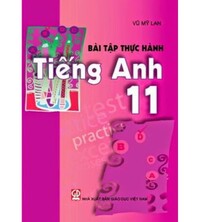Đề thi môn tiếng Anh lớp 11 giữa kì 1
Đề thi giữa học kì 1 môn tiếng Anh 11 mới dưới đây nằm trong bộ đề thi giữa kì 1 lớp 11 năm 2023 do Tìm Đáp Án sưu tầm và đăng tải. Đề luyện thi tiếng Anh gồm nhiều dạng bài tập trắc nghiệm tiếng Anh lớp 11 khác nhau giúp các em học sinh cải thiện kỹ năng làm bài hiệu quả.
I. LISTENING (2.5 points)
TASK 1. Listen to some information about a student’s health and habits. Circle the best answer A, B, or C. You will listen TWICE.
1. What did Matt love doing in his free time?
A. Watching TV and playing video games
B. Hanging out at fast food restaurants
C. Spending time with his family
2. Why does Matt want to live healthier?
A. He has just moved to live with his extended family.
B. His grandfather passed away.
C. His uncle was diagnosed with a heart disease.
3. How does Matt eat more healthily?
A. He stops eating foods with fat and salt.
B. He wakes up earlier to have breakfast.
C. He has a quick breakfast before going to school.
4. What does Math pay more attention to?
A. His appearance
B. His fitness
C. His heart condition
5. Why does Matt go to cooking class?
A. Because there’s no fast food restaurant near his college.
B. Because he thinks he should know how to cook.
C. Because he wants to spend time with his mother.
TASK 2. Listen to a student and her grandfather and complete the summary. Write NO MORE THAN THREE WORDS AND/ OR A NUMBER in each blank. You will listen TWICE.
Summary
After watching a (1) ___________ about cities in the future, Anna asks her grandfather to describe their city when he was young. Back then, the city looked different because there weren’t any (2) __________________. Anna’s grandfather predicts a rise in (3) ___________ and the number of tall buildings in the future. He voices concern about the city’s (4) ___________ such as pollution, traffic jams and a lack of (5) _______________. Anna mentions some solutions in the documentary that it shows and convinces her grandfather to watch it.
II. READING (2.5 points)
TASK 1. Read the passage. Circle the best answer A, B, or C to each of the questions.
Is the generation gap in America no longer a severe problem as it used to be? Dating back to the 1960s when teenagers tended to lash out the values and goals of their parents as well as rebel against the authority figures, the incendiary conflicts between older and younger generations increased sharply. It’s because teenagers' world wasn’t any longer limited in a narrow society that wasn’t mobile, and instead of going to church every weekend, they were exposed to various forms of social media like television and radios. They got access to huge sources of new ideas, which liberated them from old-fashioned and boring lifestyles whereas many older people were conservative and didn’t accept differences disturbing their normal life. Over time, however, the tension between generations has been alleviated due to the improved mutual understanding of baby boomers, Millennials and even Zillennials in many fields of life. According to recent research, the largest generational discrepancies between young and old in the United States are the use of technology and taste in music. Nevertheless, in terms of technological use, many older people gradually learn how to use a laptop or smartphone to surf the Internet from their children and especially their grandchildren due to their recognition of huge technological benefits. Regarding the musical differences, unlike in the past, older generations nowadays appear to give fewer critical remarks on what type of music teens should listen to and begin to accept the variety of music tastes when living under the same roofs.
1. What is the passage mainly about?
A. The development of the generation gap in America nowadays.
B. The alleviation of the generation gap in America nowadays.
C. The eradication of the generation gap in America in the past.
D. The reduction of the generation gap in America in the past.
2. What does the word they in line 8 mean?
A. Teenagers.
B. Forms of social media.
C. Parents.
D. Older generations
3. According to the passage, what types of social media provided young people with new ideas in the 1960s?
A. The Internet and television.
B. The Internet and radios.
C. The television and printed newspaper.
D. The television and radios.
4. Why did the older generation refuse to access new things?
A. Because they thought those things were tedious.
B. Because they loved to go to church every weekend.
C. Because they didn’t want to change their normal life.
D. Because they weren’t able to learn technological devices.
5. What can be inferred from the passage?
A. Nowadays there is no longer a generation gap.
B. The generation gap didn’t remain after the 1960s.
C. Teaching older people to use modern devices can bridge the gap between generations.
D. Younger Americans are forced to change their taste in music nowadays.
*Tải file để xem chi tiết*
Xem thêm: Đề thi giữa học kì 1 Tiếng Anh 11 Global Success MỚI
Trên đây là trọn bộ Đề thi giữa học kì 1 Tiếng Anh 11 Global Success.







